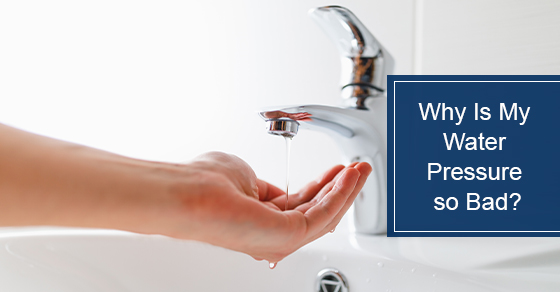 26
May 2021
26
May 2021
Why Is My Water Pressure so Bad?
Most homeowners are not aware of how important the water pressure in their pipes is to their daily life. But when it comes to washing dishes or having a nice, hot shower at the end of a long day, if your water pressure is low, you’re going to be disappointed.
While low water pressure can be annoying, it’s not always a sign of a big plumbing problem. Sometimes it’s an easy fix, yet other times it could be a bit more complicated to repair. The only way to be sure is to contact a professional plumber. In Toronto, you can find 24-hour emergency plumbing services to help you solve your water pressure problems.
Here are some of the most common reasons you might have low water pressure and what to do about it.
1. Main shutoff valve
Checking to see that your main shutoff valve is in the correct position is one of the first steps that homeowners should take if they have low water pressure. This valve is the main gateway for water entering your home, so it can cause low pressure in your pipes if it is not fully open. To locate the main shutoff valve, look around your basement or on the outside wall of your home. You’ll recognize it as either a wheel handle or lever handle. A tip if you are looking at the outside of your home for the valve, look on the wall that is facing the street as municipal water usually enters your house from this direction.
Turn the wheel counterclockwise to open up the valve. If you have a lever, move it so it is parallel with the pipe. It is essential to know that you are in charge of your main shutoff valve. If a professional plumber comes into your home to do work, they may need to know where the valve is. And it is a good idea to check it when they go to make sure it is fully open.
2. Water meter valve
Like your main shutoff valve, you’ll want to ensure your water meter valve is open and not slowing down your water pressure. However, do not tamper with the valve in any way. It belongs to the municipality, and they are the only ones who can open and close it. You will find it near your water meter. An open valve sits parallel with the pipe. If you notice that it is at an angle, you’ll need to get in touch with the water department and have them come out to adjust it.
3. Hot water heater
Surprisingly, your hot water heater can impact the pressure of both your hot and cold water. If your water heater is causing the problem, it may be due to hard water build-up or the water heater valve. Minerals in the water can collect in your water heater and connecting pipes. This can block the water from flowing out.
Every water heater has a shutoff valve for emergencies. If for some reason it was turned off, it will impact your water pressure. You’ll need to move it back to the open position so the water can flow better through your pipes. Because water heaters can be dangerous, it is best to leave the repair work to a professional plumber. This not only keeps you and others in your home safe but it ensures that the job gets done right.
4. Aerator screen clog
This is the mesh screen on the end of your tap where the water flows out. They are used to manage water flow and conserve water. If the aerator screen becomes clogged, it will reduce the water flow, sometimes significantly. If you are finding that the water pressure problem is just happening in one faucet, it could be the aerator screen is clogged. You can remove the screen and clean it. Once you put it back on, your water pressure problem should be gone. If not, you need to contact a professional plumber to address the problem.
5. Clogged/corroded pipes
A more serious issue that could be slowing down the flow of water in your pipes is a clog. Build-up often accumulates in a single area in your pipes and while water can move around it, there will be reduced flow and pressure.
When the water has a strange taste or colour, it might be that your pipes are corroded rather than clogged. It is important to call a professional plumber who has the knowledge and tools to be able to detect where the clog is or how to handle the corrosion. Both of these issues are serious and, if left unchecked can lead to bigger problems, including burst pipes.
6. Leaks
When a pipe starts leaking, you’ll notice less water coming out of your taps. It is a good idea to look around your home for water stains. Examine underneath cupboards, near the washing machine and around toilets. Take note of any water stains on ceilings or walls. When a pipe starts leaking, it can cause mould or mildew to grow. So you will want to hire a plumber to take care of it as soon as possible.
7. Shared pipe woes
Some homes share pipes with neighbours. This can impact your water pressure because it is divided between two homes. It is most noticeable when your neighbour is using water for laundry or a shower. The best way to handle sharing pipes with your neighbours is to adjust your schedule and try to use water at different times from them. If it becomes a bigger problem for you, contact your plumber about a pipe replacement. While it will cost you some money to have the work done, it can be worth it.
For more information about fixing low water pressure issues, call Brothers Plumbing at 1-800-742-8471 or contact us here.
